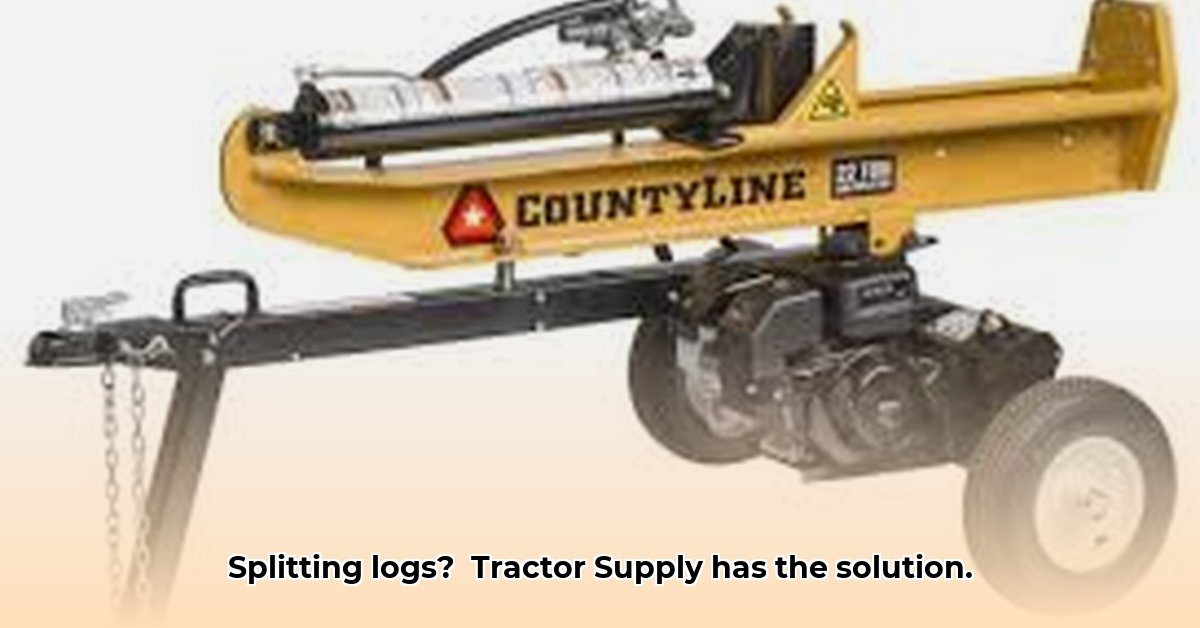
Choosing the Right Log Splitter for Sustainable Farming
Sustainable farming demands smart choices, and your tools are no exception. A log splitter can significantly impact your farm's efficiency and environmental footprint. This guide helps you select the ideal log splitter from Tractor Supply, aligning with sustainable practices. We'll cover choosing the right power source, size, safety features, and maintenance, ultimately demonstrating how efficient wood processing contributes to a greener farm. For more information on finding the right splitter, check out our detailed guide on Tractor Supply Log Splitters.
Power Source: Gas vs. Electric – Sustainability Considerations
The choice between gas and electric log splitters significantly impacts your farm's sustainability. Gas-powered models typically offer greater power for larger logs, but their emissions contribute to a larger carbon footprint. Electric models, conversely, are quieter, cleaner, and more environmentally friendly, ideal for smaller farms or those prioritizing reduced emissions. The best option depends on your farm's specific needs and priorities. Do you prioritize raw power or minimizing your environmental impact?
Size and Capacity: Matching Your Needs
Selecting the right splitter capacity prevents both energy waste and inefficiency. An oversized splitter uses more energy than necessary, while an undersized one struggles with larger logs, leading to wasted time and effort. Consider the average size of the logs you'll be splitting. While slightly overestimating capacity allows for future flexibility, it's crucial to avoid unnecessary expense and energy consumption.
Safety Features: Protecting Yourself and Your Investment
Safety is paramount when operating heavy machinery. Look for splitters with essential safety features such as automatic shutoff switches (preventing accidents from jammed logs), wedge guards (protecting hands), and a well-built, sturdy design. Regular maintenance is also a key component of safe operation; a well-maintained splitter is a safer splitter.
Maintenance: Extending Lifespan and Reducing Environmental Impact
Regular maintenance extends the lifespan of your log splitter, minimizing waste from premature replacements. This reduces the environmental impact associated with manufacturing and disposing of new parts. Your maintenance routine should include regular cleaning to remove debris, lubrication of moving parts according to the manufacturer's instructions, blade sharpening (ensuring efficient splitting), and prompt attention to any signs of damage or wear.
Sustainable Wood Sourcing: Responsible Forestry Practices
Sustainable wood sourcing is crucial for environmentally responsible farming. Avoid contributing to deforestation and illegal logging by following these practices:
Source Locally: Reduce transportation emissions by sourcing wood from nearby sustainably managed forests. This minimizes your carbon footprint associated with transportation.
Check Certifications: Look for certifications like the Forest Stewardship Council (FSC) label. This guarantees the wood originates from responsibly managed forests, employing sustainable harvesting methods.
Transparency and Traceability: Inquire about your supplier's forestry practices. Transparency and clear sourcing are hallmarks of sustainable forestry. Avoid suppliers who cannot provide details about their wood's origin.
Efficient Log Splitting Techniques: Maximizing Efficiency and Minimizing Waste
Efficient log splitting techniques further enhance sustainability. These tips maximize your splitter's performance and minimize waste:
Proper Log Preparation: Remove dirt, rocks, and any debris from logs before splitting; this protects the splitter’s blade and ensures a clean split.
Secure Log Placement: Securely position each log to prevent jamming and potential injuries. Never force a log; a jammed log can cause damage and injury.
Strategic Splitting: Start with smaller logs before tackling larger ones. This hones your technique and prevents unnecessary stress on the equipment, improving efficiency.
Safety Procedures: Prioritizing Safety in All Operations
Log splitters are powerful tools requiring utmost caution. Always follow these safety guidelines:
Personal Protective Equipment (PPE): Always wear safety glasses, gloves, sturdy boots, and hearing protection when operating a log splitter.
Consult the Manual: Before using the machine, carefully read the manufacturer’s instructions and follow them meticulously.
Maintain Safe Distance: Maintain a safe distance from moving parts throughout the operation.
Regular Inspection: Always inspect the log splitter thoroughly before each use for any signs of wear, damage, or loose parts.
Conclusion: Sustainable Farming Through Responsible Choices
Selecting and maintaining a log splitter from Tractor Supply aligns seamlessly with broader sustainable farming practices. Remember, responsible wood sourcing and efficient operation minimize your environmental impact. By combining smart equipment choices with responsible methods, you can contribute to a more sustainable and efficient farm operation. The combination of efficient tools and responsible practices forms the basis for a thriving, environmentally conscious farm.